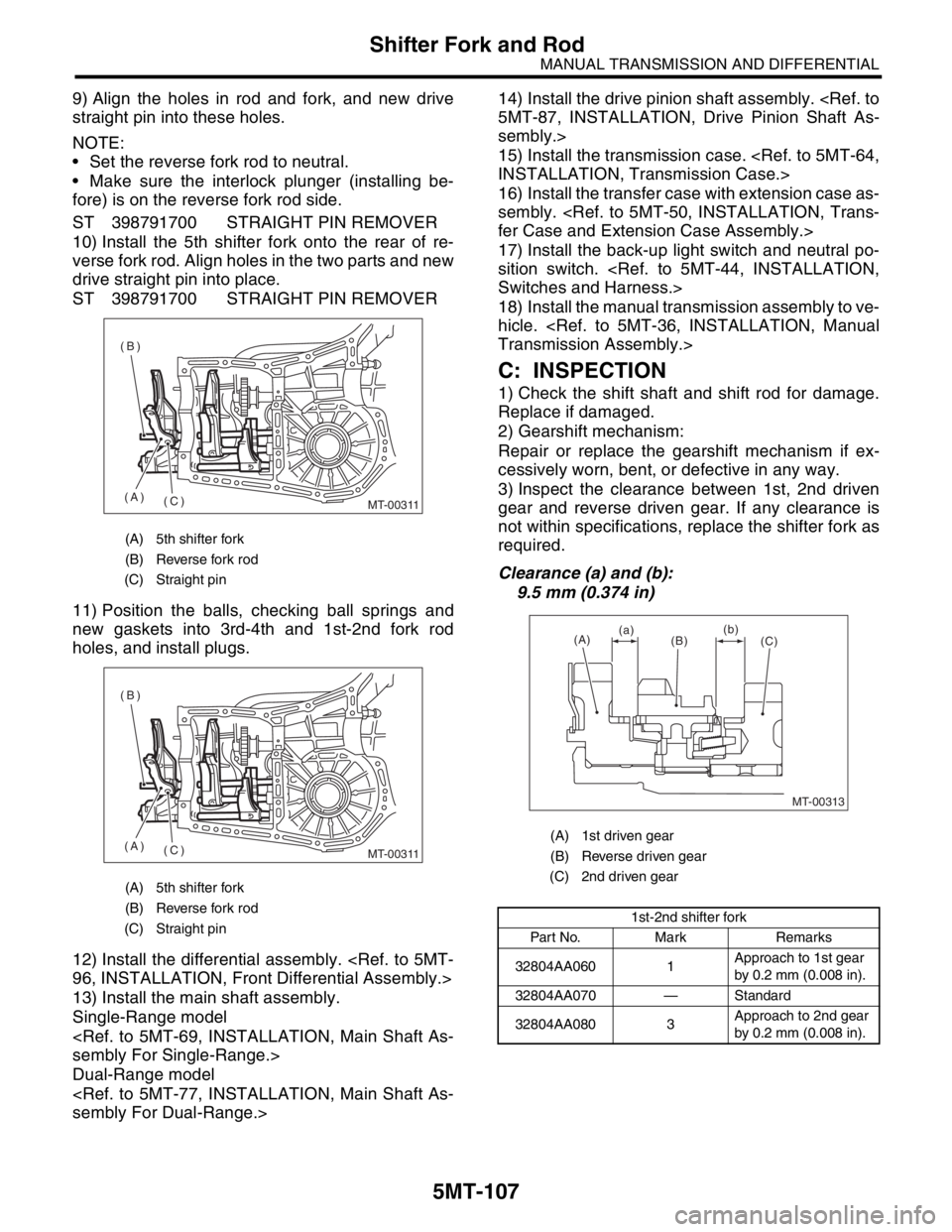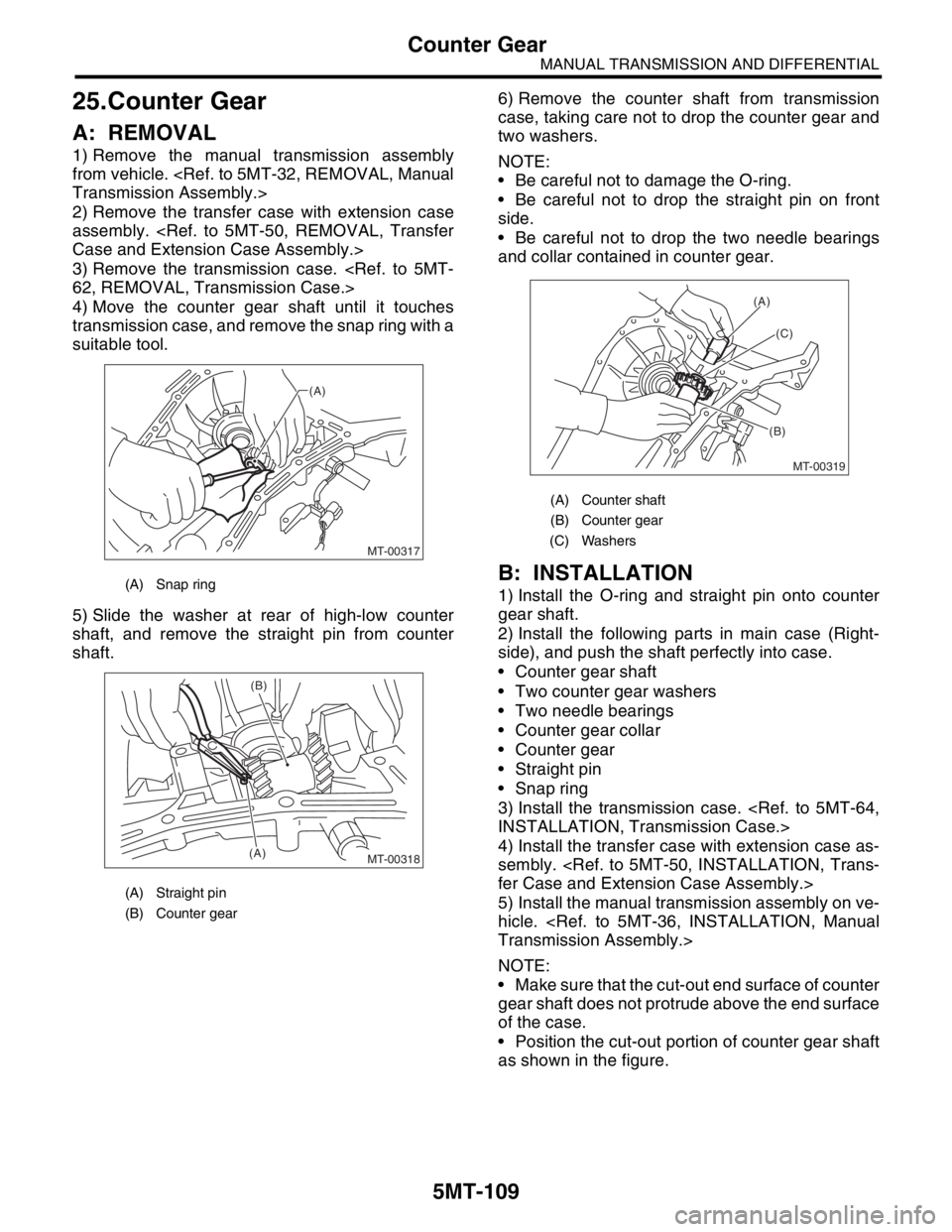2004 SUBARU FORESTER manual transmission
[x] Cancel search: manual transmissionPage 2819 of 2870

5MT-106
MANUAL TRANSMISSION AND DIFFERENTIAL
Shifter Fork and Rod
24.Shifter Fork and Rod
A: REMOVAL
1) Remove the manual transmission assembly
from vehicle.
2) Remove the back-up light switch and neutral po-
sition switch.
3) Remove the transfer case with extension case
assembly.
4) Remove the transmission case.
5) Remove the drive pinion shaft assembly.
bly.>
6) Remove the main shaft assembly.
Single-Range model
Dual-Range model
7) Remove the differential assembly.
8) Drive out the straight pin with ST, and 5th shifter
fork.
ST 398791700 STRAIGHT PIN REMOVER
9) Remove the plugs, springs and checking balls.10) Drive out the straight pin, and pull out 3-4 fork
rod and shifter fork.
NOTE:
When removing the rod, keep other rods in neutral.
11) Drive out the straight pin, and pull out 1st-2nd
fork rod and shifter fork.
12) Remove the outer snap ring, and pull out the
reverse shifter rod arm from reverse fork rod. Then
take out the ball, spring and interlock plunger from
rod.
And then remove the rod.
NOTE:
When pulling out the reverse shifter rod arm, be
careful not to let the ball pop out of arm.
13) Remove the reverse shifter lever.
B: INSTALLATION
1) Apply grease to plunger.
ST 399411700 ACCENT BALL INSTALLER
2) Install the reverse arm fork spring, ball and inter-
lock plunger to reverse fork rod arm. Insert the re-
verse fork rod into hole in reverse fork rod arm, and
hold it with outer snap ring using ST.
3) Position the ball, spring and new gasket in re-
verse shifter rod hole, on left side transmission
case, and tighten the checking ball plug.
4) Install the 1st-2nd fork rod into 1st-2nd shifter
fork via the hole on the rear of transmission case.
5) Align the holes in rod and fork, and new drive
straight pin into these holes using ST.
NOTE:
Set other rods to neutral.
Make sure the interlock plunger is on the 3rd-4th
fork rod side.
ST 398791700 STRAIGHT PIN REMOVER
6) Apply a coat of grease to plunger.
7) Install the interlock plunger onto 3rd-4th fork rod.
8) Install the 3rd-4th fork rod into 3rd-4th shifter fork
via the hole on the rear of transmission case.
(A) Straight pin
(B) 5th shifter fork
MT-00309(A) (B)
(A) Straight pin
(B) 3rd-4th fork rod
(C) Shifter fork
MT-00310(A)
(B) (C)
Page 2820 of 2870

5MT-107
MANUAL TRANSMISSION AND DIFFERENTIAL
Shifter Fork and Rod
9) Align the holes in rod and fork, and new drive
straight pin into these holes.
NOTE:
Set the reverse fork rod to neutral.
Make sure the interlock plunger (installing be-
fore) is on the reverse fork rod side.
ST 398791700 STRAIGHT PIN REMOVER
10) Install the 5th shifter fork onto the rear of re-
verse fork rod. Align holes in the two parts and new
drive straight pin into place.
ST 398791700 STRAIGHT PIN REMOVER
11) Position the balls, checking ball springs and
new gaskets into 3rd-4th and 1st-2nd fork rod
holes, and install plugs.
12) Install the differential assembly.
13) Install the main shaft assembly.
Single-Range model
Dual-Range model
sembly.>
15) Install the transmission case.
16) Install the transfer case with extension case as-
sembly.
17) Install the back-up light switch and neutral po-
sition switch.
18) Install the manual transmission assembly to ve-
hicle.
C: INSPECTION
1) Check the shift shaft and shift rod for damage.
Replace if damaged.
2) Gearshift mechanism:
Repair or replace the gearshift mechanism if ex-
cessively worn, bent, or defective in any way.
3) Inspect the clearance between 1st, 2nd driven
gear and reverse driven gear. If any clearance is
not within specifications, replace the shifter fork as
required.
Clearance (a) and (b):
9.5 mm (0.374 in)
(A) 5th shifter fork
(B) Reverse fork rod
(C) Straight pin
(A) 5th shifter fork
(B) Reverse fork rod
(C) Straight pin
MT-00311(C) (A) (B)
MT-00311(C) (A) (B)(A) 1st driven gear
(B) Reverse driven gear
(C) 2nd driven gear
1st-2nd shifter fork
Part No. Mark Remarks
32804AA060 1Approach to 1st gear
by 0.2 mm (0.008 in).
32804AA070 — Standard
32804AA080 3Approach to 2nd gear
by 0.2 mm (0.008 in).
MT-00313
(A)
(B)
(C) (a)(b)
Page 2821 of 2870

5MT-108
MANUAL TRANSMISSION AND DIFFERENTIAL
Shifter Fork and Rod
4) Inspect the clearance between 3rd, 4th drive
gear and coupling sleeve. If any clearance is not
within specifications, replace the shifter fork as re-
quired.
Clearance (a) and (b):
9.3 mm (0.366 in)
5) Inspect the clearance between 5th drive gear
and coupling sleeve. If any clearance is not within
specifications, replace the shifter fork as required.
Clearance (a):
9.3 mm (0.366 in) 6) Inspect the rod end clearances (A) and (B). If
any clearance is not within specifications, replace
the rod or fork as required.
Clearance (A):
1st-2nd to 3rd-4th:
0.4 — 1.4 mm (0.016 — 0.055 in)
Clearance (B):
3rd-4th to 5th:
0.5 — 1.3 mm (0.020 — 0.051 in)
(A) 3rd drive gear
(B) Coupling sleeve
(C) 4th drive gear
3rd-4th shifter fork
Part No. Mark Remarks
32810AA061 1Approach to 4th gear
by 0.2 mm (0.008 in).
32810AA071 — Standard
32810AA101 3Approach to 3rd gear
by 0.2 mm (0.008 in).
(A) 5th drive gear
(B) Coupling sleeve
MT-00940
(A)(B)
(C) (a) (b)
MT-00315
(A)(B) (a)
5th shifter fork (Non-turbo)
Part No. Mark Remarks
32812AA201 7Approach to 5th gear
by 0.2 mm (0.008 in).
32812AA211 — Standard
32812AA221 9Approach to 5th gear
by 0.2 mm (0.008 in).
5th shifter fork (Turbo)
Part No. Mark Remarks
32812AA231 7Approach to 5th gear
by 0.2 mm (0.008 in).
32812AA241 — Standard
32812AA251 9Become distant from
5th gear by 0.2 mm
(0.008 in).
MT-00379
(B)(A)
Page 2822 of 2870

5MT-109
MANUAL TRANSMISSION AND DIFFERENTIAL
Counter Gear
25.Counter Gear
A: REMOVAL
1) Remove the manual transmission assembly
from vehicle.
2) Remove the transfer case with extension case
assembly.
3) Remove the transmission case.
4) Move the counter gear shaft until it touches
transmission case, and remove the snap ring with a
suitable tool.
5) Slide the washer at rear of high-low counter
shaft, and remove the straight pin from counter
shaft.6) Remove the counter shaft from transmission
case, taking care not to drop the counter gear and
two washers.
NOTE:
Be careful not to damage the O-ring.
Be careful not to drop the straight pin on front
side.
Be careful not to drop the two needle bearings
and collar contained in counter gear.
B: INSTALLATION
1) Install the O-ring and straight pin onto counter
gear shaft.
2) Install the following parts in main case (Right-
side), and push the shaft perfectly into case.
Counter gear shaft
Two counter gear washers
Two needle bearings
Counter gear collar
Counter gear
Straight pin
Snap ring
3) Install the transmission case.
4) Install the transfer case with extension case as-
sembly.
5) Install the manual transmission assembly on ve-
hicle.
NOTE:
Make sure that the cut-out end surface of counter
gear shaft does not protrude above the end surface
of the case.
Position the cut-out portion of counter gear shaft
as shown in the figure.(A) Snap ring
(A) Straight pin
(B) Counter gear
MT-00317
(A)
MT-00318(A)
(B)
(A) Counter shaft
(B) Counter gear
(C) Washers
MT-00319
(A)
(B)(C)
Page 2823 of 2870

5MT-110
MANUAL TRANSMISSION AND DIFFERENTIAL
Counter Gear
C: INSPECTION
1) After installing the snap ring, measure the clear-
ance between snap ring and counter washer.
Clearance:
0.05 — 0.35 mm (0.0020 — 0.0138 in)
2) If the clearance is out of measured value, select
a snap ring and install to put clearance within mea-
sured value.
D: ADJUSTMENT
Selection of snap ring:
If the measurement is not within specification, se-
lect suitable snap ring.
Snap ring
Part No. Thickness mm (in)
031319000 1.50 (0.0591)
805019010 1.72 (0.0677)
Page 2824 of 2870

5MT-111
MANUAL TRANSMISSION AND DIFFERENTIAL
General Diagnostic
26.General Diagnostic
A: INSPECTION
1. MANUAL TRANSMISSION
Symptom Possible cause Remedy
1. Gears are difficult to intermesh.
N
OTE:
The cause for difficulty in shifting gears
can be classified into two kinds: one is
malfunction of the gear shift system and
the other is malfunction of the transmis-
sion. However, if the operation is heavy
and engagement of the gears is difficult,
defective clutch disengagement may also
be responsible. Check whether the clutch
is correctly functioning, before checking
the gear shift system and transmission.(a) Worn, damaged or burred chamfer of
internal spline of sleeve and reverse
driven gearReplace.
(b) Worn, damaged or burred chamfer of
spline of gearsReplace.
(c) Worn or scratched bushings Replace.
(d) Incorrect contact between synchro-
nizer ring and gear cone or wear Correct or replace.
2. Gear slips out.
Gear slips out when coasting on rough
road.
Gear slips out during acceleration.(a) Defective pitching stopper adjustment Adjust.
(b) Loose engine mounting bolts Tighten or replace.
(c) Worn fork shifter, broken shifter fork
rail springReplace.
(d) Worn or damaged ball bearing Replace.
(e) Excessive clearance between splines
of synchronizer hub and synchronizer
sleeveReplace.
(f) Worn tooth step of synchronizer hub Replace.
(g) Worn 1st driven gear and driven shaft Replace.
(h) Worn 2nd driven gear and 2nd bush Replace.
(i) Worn reverse idler gear and bushing Replace.
3. Unusual noise comes from transmis-
sion.
N
OTE:
If an unusual noise is heard when the ve-
hicle is parked with its engine idling and if
the noise ceases when the clutch is disen-
gaged, it may be considered that the
noise comes from the transmission.(a) Insufficient or improper lubrication Lubricate or replace with specified oil.
(b) Worn or damaged gears and bearings
NOTE:
If the trouble is only wear of the tooth sur-
faces, merely a high roaring noise will oc-
cur at high speeds, but if any part is
broken, rhythmical knocking sound will be
heard even at low speeds.Replace.
Page 2825 of 2870

5MT-112
MANUAL TRANSMISSION AND DIFFERENTIAL
General Diagnostic
2. DIFFERENTIAL
Symptom Possible cause Remedy
1. Broken differential (case, gear, bear-
ing, etc.)
N
OTE:
Noise will develop and finally it will be-
come impossible to continue to run due to
broken pieces obstructing the gear revo-
lution. (a) Insufficient or improper oil Disassemble the differential and replace
broken components and at the same time
check other components for any trouble,
and replace if necessary.
(b) Use of vehicle under severe condi-
tions such as excessive load and
improper use of clutch Readjust the bearing preload and back-
lash and face contact of gears.
(c) Improper adjustment of taper roller
bearingAdjust.
(d) Improper adjustment of drive pinion
and hypoid driven gear Adjust.
(e) Excessive backlash due to worn dif-
ferential side gear, washer or differential
pinion vehicle under severe operating
conditions. Add recommended oil to specified level.
Do not use the vehicle under severe oper-
ating conditions.
(f) Loose hypoid driven gear clamping
boltsTighten.
2. Differential and hypoid gear noises
Troubles of the differential and hypoid
gear always appear as noise problems.
Therefore noise is the first indication of
the trouble. However noises from the
engine, muffler, tire, exhaust gas, bear-
ing, body, etc. are easily mistaken for the
differential noise. Pay special attention to
the hypoid gear noise because it is easily
confused with other gear noises. There
are the following four kinds of noises.
Gear noise when driving: If noise
increases as vehicle speed increases it
may be due to insufficient gear oil, incor-
rect gear engagement, damaged gears,
etc.
Gear noise when coasting: Damaged
gears due to maladjusted bearings and
incorrect shim adjustment
Bearing noise when driving or when
coasting: Cracked, broken or damaged
bearings
Noise which mainly occurs when turn-
ing: Unusual noise from differential side
gear, differential pinion, differential pinion
shaft, etc. (a) Insufficient oil Lubricate.
(b) Improper adjustment of hypoid driven
gear and drive pinionCheck tooth contact.
(c) Worn teeth of hypoid driven gear and
drive pinionReplace as a set.
Readjust the bearing preload.
(d) Loose roller bearing Readjust the hypoid driven gear to drive
pinion backlash and check tooth contact.
(e) Distorted hypoid driven gear or differ-
ential caseReplace.
(f) Worn washer and differential pinion
shaftReplace.
Page 2826 of 2870

FUJI HEAVY INDUSTRIES LTD. G8080GE5
2004 FORESTER SERVICE MANUAL QUICK REFERENCE INDEX
TRANSMISSION SECTION
This service manual has been prepared
to provide SUBARU service personnel
with the necessary information and data
for the correct maintenance and repair
of SUBARU vehicles.
This manual includes the procedures
for maintenance, disassembling, reas-
sembling, inspection and adjustment of
components and diagnostics for guid-
ance of experienced mechanics.
Please peruse and utilize this manual
fully to ensure complete repair work for
satisfying our customers by keeping
their vehicle in optimum condition.
When replacement of parts during
repair work is needed, be sure to use
SUBARU genuine parts.
All information, illustration and specifi-
cations contained in this manual are
based on the latest product information
available at the time of publication
approval.CONTROL SYSTEM CS
AUTOMATIC TRANSMISSION 4AT
AUTOMATIC TRANSMISSION
(DIAGNOSTIC)4AT(H4SO)
AUTOMATIC TRANSMISSION
(DIAGNOSTIC)4AT(H4DOTC)
AUTOMATIC TRANSMISSION
(DIAGNOSTIC)4AT(H4DOTC 2.5)
MANUAL TRANSMISSION AND
DIFFERENTIAL5MT
CLUTCH SYSTEM CL